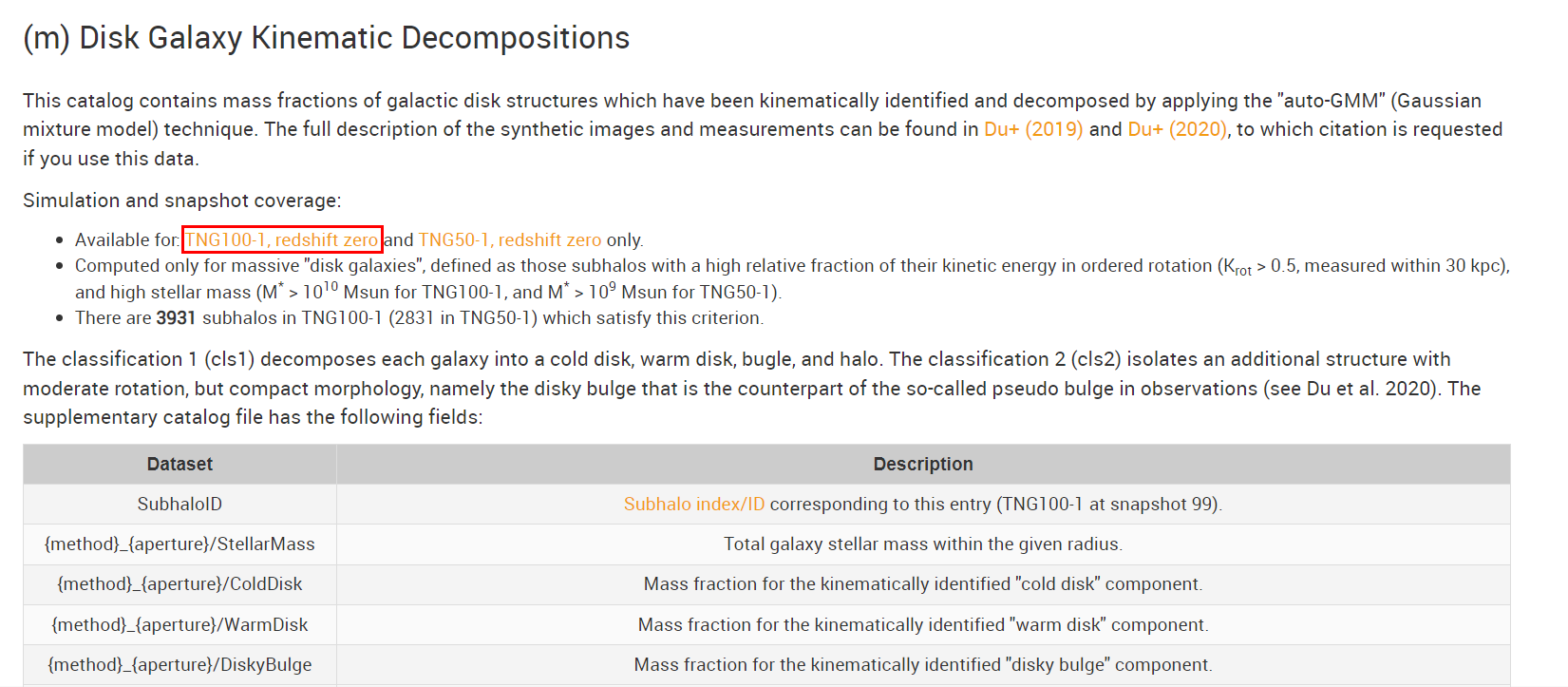How to access supplementary data in the JupyterLab WorkSpace
怡远 张
4 Feb
Hi!
I'm wondering that how to use the supplementary data when I research by the JupyterLab WorkSpace.For example,where(or which file) should I look for these datas in JupyterLab if I want to know the bulge masses of the galaxies by using (m) Disk Galaxy Kinematic Decompositions?When I clicked the link' TNG100-1, redshift zero '(Fig attachment),the hdf5 file was downloaded to my desktop instead of my JupyterLab service,so I still couldn't use it in JupyterLab.
Looking forward to your reply!
Best wishes,
Zhang
Dylan Nelson
5 Feb
On the Lab, you will find some supplementary catalogs available under /postprocessing/ (of each run), but not many.
For small catalogs, like (m) Disk Galaxy Kinematic Decompositions, you should just get this into your Lab yourself. You can either (i) download it to your local computer, then upload it into the Lab using the "Upload Files" button, or by dragging and dropping it into the file listing panel. Or (ii) use wget from the Lab terminal to download it directly into your Lab.
Sorry to bother you again.I have drop the supplementary data file'kinematic_decomposition_099.hdf5' into my file listing panel,but I don't know how to read this file,could you give me some sample code?For your convenience,just assume that I want to get the ‘Mass fraction for the kinematically identified "bulge" component’,i.e.the{class1}_{1re}/Bulge.Thanks again!
Looking forward to your reply!
Best wishes,
Zhang
Dylan Nelson
6 Feb
This is a basic HDF5 file, I would suggest the h5py tutorial.
怡远 张
8 Feb
Sincerely thank you for your reply!
Another question for the fields in sanpshot and groupcat is what is the difference between the 'BH_HostHaloMass' and 'SubhaloMass'?I noticed that the 'BH_HostHaloMass' means the mass of the parent FoF halo of this blackhole',so whether could I treat it as the mass of the host dark matter halo where the black hole is located,if it is 'yes',then why it is inconsist with the values of the 'SubhaloMass' (or maybe the values of the second'SubhaloMassType'(dm mass))?There exists a wide discrepancy,e.g.'BH_HostHaloMass' equals 38786.4765625 while 'SubhaloMass' equals 3666.62280273438 or the second'SubhaloMassType'(dm mass) equals 3184.08618164063(I have processed the datas so that the datas of the PartType5(BH) can correspond to the datas of its host subhalo).Is it caused by the particles/cells bound to subhaloes of the subhalo are not account for the 'SubhaloMass' whereas the BH_HostHaloMass'contains?
A small suggestion,by the way,I think it will be convenience if there's a search function in this part,which can make the users to search related questions and avoid some repeat questions for you.
Best Wishes for you!
Zhang
Dylan Nelson
8 Feb
I wouldn't use BH_HostHaloMass for anything, this sounds like an old field. It is probably redundant, perhaps equal exactly to GroupMass (instead of SubhaloMass). You should use GroupMass or e.g. Group_M_Crit200 (for M200c), of the parent halo of a SMBH, instead.
True about the search! The best option, now, is just a google search.
Hi!
I'm wondering that how to use the supplementary data when I research by the JupyterLab WorkSpace.For example,where(or which file) should I look for these datas in JupyterLab if I want to know the bulge masses of the galaxies by using (m) Disk Galaxy Kinematic Decompositions?When I clicked the link' TNG100-1, redshift zero '(Fig attachment),the hdf5 file was downloaded to my desktop instead of my JupyterLab service,so I still couldn't use it in JupyterLab.
Looking forward to your reply!
Best wishes,
Zhang
On the Lab, you will find some supplementary catalogs available under
/postprocessing/(of each run), but not many.For small catalogs, like
(m) Disk Galaxy Kinematic Decompositions, you should just get this into your Lab yourself. You can either (i) download it to your local computer, then upload it into the Lab using the "Upload Files" button, or by dragging and dropping it into the file listing panel. Or (ii) use wget from the Lab terminal to download it directly into your Lab.Thank you, very useful.
Sorry to bother you again.I have drop the supplementary data file'kinematic_decomposition_099.hdf5' into my file listing panel,but I don't know how to read this file,could you give me some sample code?For your convenience,just assume that I want to get the ‘Mass fraction for the kinematically identified "bulge" component’,i.e.the{class1}_{1re}/Bulge.Thanks again!
Looking forward to your reply!
Best wishes,
Zhang
This is a basic HDF5 file, I would suggest the h5py tutorial.
Sincerely thank you for your reply!
Another question for the fields in sanpshot and groupcat is what is the difference between the 'BH_HostHaloMass' and 'SubhaloMass'?I noticed that the 'BH_HostHaloMass' means the mass of the parent FoF halo of this blackhole',so whether could I treat it as the mass of the host dark matter halo where the black hole is located,if it is 'yes',then why it is inconsist with the values of the 'SubhaloMass' (or maybe the values of the second'SubhaloMassType'(dm mass))?There exists a wide discrepancy,e.g.'BH_HostHaloMass' equals 38786.4765625 while 'SubhaloMass' equals 3666.62280273438 or the second'SubhaloMassType'(dm mass) equals 3184.08618164063(I have processed the datas so that the datas of the PartType5(BH) can correspond to the datas of its host subhalo).Is it caused by the particles/cells bound to subhaloes of the subhalo are not account for the 'SubhaloMass' whereas the BH_HostHaloMass'contains?
A small suggestion,by the way,I think it will be convenience if there's a search function in this part,which can make the users to search related questions and avoid some repeat questions for you.
Best Wishes for you!
Zhang
I wouldn't use
BH_HostHaloMassfor anything, this sounds like an old field. It is probably redundant, perhaps equal exactly toGroupMass(instead ofSubhaloMass). You should useGroupMassor e.g.Group_M_Crit200(for M200c), of the parent halo of a SMBH, instead.True about the search! The best option, now, is just a google search.